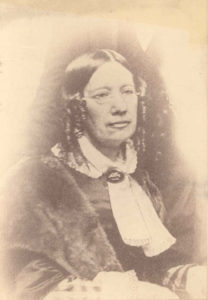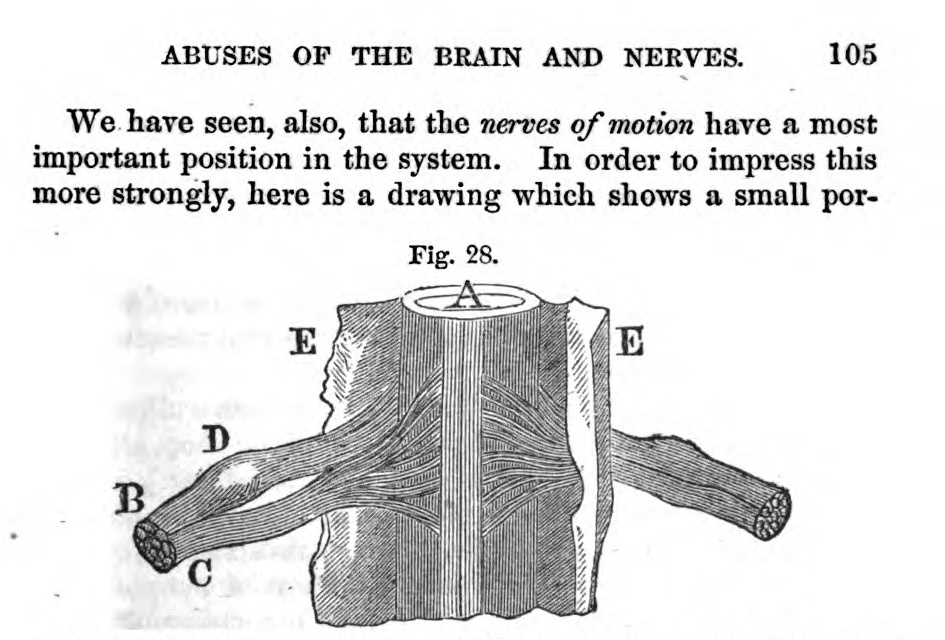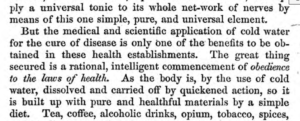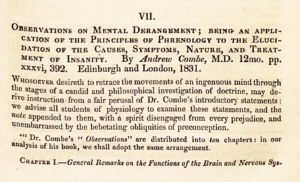Phrenology, the Freud of the 19th C (Todd, Part IV)

A Review of Andrew Combe, M.D.’s Observations on Mental Derangement in The Medico-Chirurgical Review 16, no. 32 (April 1, 1832): 423–34. (My research, not in Todd’s book.)
Part IV of Reflections on Jan Todd’s Physical Culture and the Body Beautiful: Purposive Exercise in the Lives of American Women, 1800-1870.
Chapter 6: Becoming Catherine Beecher
Much has been written about educator Catherine Beecher, but almost nothing about her work on exercise for women. When she first opened her seminary for girls in Hartford, her brother cautioned her that “The mind cannot bear the intense application to any one subject for a long time, without interruption, nor will the body, without much care, bear it. I would advise you, therefore, to take much exercise” (Todd, 141). He felt that Catherine didn’t care for her health and insisted that she “self-care” (anachronism alert. “Self-care” was not a common term until the late 20th century). He counseled her to take time for herself, sleep well, and take exercise as medical therapy.
So wrought from the work of starting her school, in 1829, Beecher had a nervous breakdown and couldn’t read, write, or listen to conversation. She blamed it on too much work and her disregard of the “non-natural Laws of Health—ideas about proper health regimen that began in ancient Greece. Overworked nerves continued to plague her. To help, family friend Elizabeth Blackwell, America’s first woman MD, gave her exercise books.

Blackwell had met the Beecher family as a teen in Cincinnati in 1838. She fought to earn a medical degree, and finally did so at the Geneva Medical College in New York in 1849. After, she studied in Europe where she learned the Swedish Movement Cure (Per Ling’s Swedish Gymnastics) from his student Professor Georgii. She returned to the US in 1851 and opened a practice on University Place, near Washington Square in NYC. Unable to find patients, she gave lectures on physical education for women. These lectures, about $14 each in 2022 USD, started her practical medical career. The following year she published her lectures as a book, The Laws of Life with Special Reference to the Physical Education of Girls.
Blackwell frequented George Taylor’s Institute of the Swedish Movement Cure in Midtown and recommended him to Catherine Beecher. It was through Blackwell that the now middle-aged Beecher came to water cure. Todd observes that Blackwell, who struggled to obtain an MD and believed that women had a right to both strength and public work, had a markedly different take on women’s place and exercise than Beecher, who taught that women should exercise gently and stay within the bounds of the home. “Woman is the Heaven-appointed guardian of health in the family, as the physician is in the community (as quoted in Todd, 149).
Like most affluent Americans, Beecher consulted both allopathic and holistic medical advice. She visited a spiritualist, a hypnotist (for eight sessions in ten days), Turkish baths (hamam), Russian baths (banya), a galvanist (who employed direct current electricity), chemical baths, sulfur baths and sun baths. Mainstream medical remedies (allopathic) included taking carbonate of iron, camphor, and bleeding. Her great preference was for hydropathy—water cure.
Beecher wrote about a hydropathy (aka hydrotherapy) spa stay in her popular physiology primer, Letters to the People on Health and Happiness (1855). For three months she woke at 4am and was wrapped in a cold sheet for two to three hours. Then, “in a reeking perspiration,” she was “immersed in the coldest plunge bath.” After, she walked as far as she could and drank “five or six tumblers of the coldest water.” By 11am she took a ten minute shower “of the coldest water” followed by more walking and more tumblers of water. At 3pm she sat with her feet “in the coldest water” and then rubbed them “until warm.”
Let’s try it.

Hydrotherapy was tremendously popular in the 1840s and 1850s. Hundreds of luxury resort spas opened to offer guests fresh air, companionship, exercise, and water cure. Beecher went to twelve different spas in this period, which allowed her a break from her work. Hydrotherapists who were often physicians immersed patients in water at different temperatures, used cold compresses, steam baths, and provided pure water for drinking. The popularity of water cure waned from the 1850s on—though it seems to be making a comeback now. Nevertheless, it gave Beecher a place to stop working, socialize, and take rest from her endless writing, organizing and publicizing.

Todd affirms that Beecher was not the originator of an exercise system but a popularizer. Her contribution “was not unlike that of the late-20th-century advertising executive. She was a promoter—savvy, culturally aware, and in touch with the zeitgeist of her America.” Todd observed this in the late 1990s, well before brand promotion of the social media age, when such savvy permeates our days.
In the mid-1850s, Catherine Beecher used her celebrity status to promote physical culture in what Todd calls the first promotional campaign of an exercise system in the U.S., replete with press packet, book tour, local newspaper ads, and local women promoters (157-158). Beecher did not advocate for women’s rights, as she believed throughout her own public career that women should remain in the domestic sphere and be subordinate to men, although she herself did not have children or marry after her fiancé died in a shipwreck. What’s good for the goose?
Chapter 7: Bigger Bodies, Better Brains: Phrenology and the Health Lift
This chapter is stellar. Phrenology, a 19th-century fad we love to mock, encouraged not only exercise, but heavy lifting for women. Haha, you say? I’d love to write about “pseudoscience” as an anachronism. We love to label erroneous belief systems “pseudoscience” as if they were always so, but usually at the time of their popularity, they were either discovered by or endorsed by mainstream scientists. Take eugenics as a prime example.
And so it was with phrenology. Jan Todd notes that historian John Davies compared phrenology’s influence on the nineteenth century to Freud’s influence on the twentieth. Both were belief systems intrinsic to American cultural beliefs. Phrenology was considered “a serious, inductive discipline” with a massive influence on popular culture.

Phrenology has also been discussed by John Lardas Modern and Emily Ogden. I’ll spare you its history and stay with the subject at hand, phrenology’s influence on exercise. Horace Mann, a Boston intellectual and a father of the American public education system, included physical education in his standard recommended curriculum only after he became interested in phrenology. But the quality of phrenological thought degraded, Todd argues, when it shifted from elite intellectuals to entrepreneurs, who turned it into fortune telling.
American popularizers of phrenology, the Fowler Brothers, endorsed physical education in the 1840s. Orson Fowler argued that physical exercise and the bigger muscles it created also enlarged the brain and improved the intellect (176). Fowler also encouraged women to build muscles and girth, including larger waists. This led to an exercise movement with heavy lifting called the health lift, created by George Barker Winthrop, who’d been influenced by phrenology. The Health Lift inspired various lifting contraptions, obvious precursors to today’s weight machines. Because of widespread belief in phrenology, this had a marked influence on American life. From the 1840s through the 1860s, heavy lifting and larger bodies became popular for both men and women because it improved physical health as well as intelligence. Pardon my presentizing, but I am reminded of Wendy Suzuki‘s work.